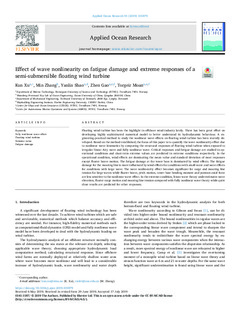| dc.contributor.author | Xu, Kun | |
| dc.contributor.author | Min, Zhang | |
| dc.contributor.author | Shao, Yanlin | |
| dc.contributor.author | Gao, Zhen | |
| dc.contributor.author | Moan, Torgeir | |
| dc.date.accessioned | 2019-08-29T11:34:34Z | |
| dc.date.available | 2019-08-29T11:34:34Z | |
| dc.date.created | 2019-08-28T08:57:19Z | |
| dc.date.issued | 2019 | |
| dc.identifier.citation | Applied Ocean Research. 2019, 91 | nb_NO |
| dc.identifier.issn | 0141-1187 | |
| dc.identifier.uri | http://hdl.handle.net/11250/2611617 | |
| dc.description.abstract | Floating wind turbine has been the highlight in offshore wind industry lately. There has been great effort on developing highly sophisticated numerical model to better understand its hydrodynamic behaviour. A engineering-practical method to study the nonlinear wave effects on floating wind turbine has been recently developed. Based on the method established, the focus of this paper is to quantify the wave nonlinearity effect due to nonlinear wave kinematics by comparing the structural responses of floating wind turbine when exposed to irregular linear Airy wave and fully nonlinear wave. Critical responses and fatigue damage are studied in operational conditions and short-term extreme values are predicted in extreme conditions respectively. In the operational condition, wind effects are dominating the mean value and standard deviation of most responses except floater heave motion. The fatigue damage at the tower base is dominated by wind effects. The fatigue damage for the mooring line is more influenced by wind effects for conditions with small wave and wave effects for conditions with large wave. The wave nonlinearity effect becomes significant for surge and mooring line tension for large waves while floater heave, pitch motion, tower base bending moment and pontoon axial force are less sensitive to the nonlinear wave effect. In the extreme condition, linear wave theory underestimates wave elevation, floater surge motion and mooring line tension compared with fully nonlinear wave theory while quite close results are predicted for other responses. | nb_NO |
| dc.language.iso | eng | nb_NO |
| dc.publisher | Elsevier | nb_NO |
| dc.rights | Attribution-NonCommercial-NoDerivatives 4.0 Internasjonal | * |
| dc.rights.uri | http://creativecommons.org/licenses/by-nc-nd/4.0/deed.no | * |
| dc.title | Effect of wave nonlinearity on fatigue damage and extreme responses of a semi-submersible floating wind turbine | nb_NO |
| dc.type | Journal article | nb_NO |
| dc.type | Peer reviewed | nb_NO |
| dc.description.version | publishedVersion | nb_NO |
| dc.source.volume | 91 | nb_NO |
| dc.source.journal | Applied Ocean Research | nb_NO |
| dc.identifier.doi | https://doi.org/10.1016/j.apor.2019.101879 | |
| dc.identifier.cristin | 1719332 | |
| dc.description.localcode | © 2019 The Authors. Published by Elsevier Ltd. Open Access CC-BY-NC-ND | nb_NO |
| cristin.unitcode | 194,64,20,0 | |
| cristin.unitname | Institutt for marin teknikk | |
| cristin.ispublished | true | |
| cristin.fulltext | original | |
| cristin.qualitycode | 1 | |

